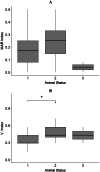Antimicrobial resistance and virulence profiles of Enterobacterales isolated from two-finger and three-finger sloths (Choloepus hoffmanni and Bradypus variegatus) of Costa Rica
- PMID: 35295556
- PMCID: PMC8919844
- DOI: 10.7717/peerj.12911
Antimicrobial resistance and virulence profiles of Enterobacterales isolated from two-finger and three-finger sloths (Choloepus hoffmanni and Bradypus variegatus) of Costa Rica
Abstract
Background: Wildlife has been recently recognized as an environmental reservoir for antimicrobial resistance (AMR). However, less information on this topic is available in animals released back into the wild after rehabilitation in wildlife facilities, compared with studies performed exclusively in captive or free-ranging wildlife. This study aimed to evaluate the potential influence of captivity and/or treatment while in captivity of wild sloths on the AMR and virulence profiles of sloths' Enterobacterales.
Methods: Oral and rectal swab samples were collected from 39 two-finger (Choloepus hoffmanni) and three-finger sloths (Bradypus variegatus) of Costa Rica (n = 78) and analyzed using conventional bacteriological techniques. A generalized linear mixed model was applied to estimate the isolates' multiple antimicrobial resistance and virulence indices as a function of animal status.
Results: A considerable level of resistance was detected, especially for Citrobacter youngae and Escherichia coli, with 17.5% of isolates classified as multidrug-resistant. Virulence indices of isolates from rehabilitated sloths were significantly higher than the ones from sloths being hand-reared for shorter periods.
Conclusions: To our knowledge, this is the first description of sloths' antimicrobial resistant Enterobacterales, suggesting that sloths' rehabilitation and consequent exposure to humans, may promote the selection of bacteria with higher virulence. Ultimately, these bacteria may represent a threat to human and animal health due to their zoonotic potential and AMR and virulence profiles.
Keywords: Antimicrobial resistance; Bacterial virulence factors; Bradypus variegatus; Choloepus hoffmanni; One health; Wildlife bacteria.
© 2022 Fernandes et al.
Conflict of interest statement
The authors declare that they have no competing interests. Ana Villada and Janet Sandi are employed by the Toucan Rescue Ranch (TRR). Yolanda Ramiro was employed by TRR at the time of the experiments.
Figures


Similar articles
-
Gastrointestinal parasites and ectoparasites of Bradypus variegatus and Choloepus hoffmanni sloths in captivity from Costa Rica.J Zoo Wildl Med. 2009 Mar;40(1):86-90. doi: 10.1638/2008-0036.1. J Zoo Wildl Med. 2009. PMID: 19368244
-
Pesticide exposure on sloths (Bradypus variegatus and Choloepus hoffmanni) in an agricultural landscape of Northeastern Costa Rica.J Environ Biol. 2014 Jan;35(1):29-34. J Environ Biol. 2014. PMID: 24579518
-
SEROSURVEY OF SELECTED ARBOVIRAL PATHOGENS IN FREE-RANGING, TWO-TOED SLOTHS (CHOLOEPUS HOFFMANNI) AND THREE-TOED SLOTHS (BRADYPUS VARIEGATUS) IN COSTA RICA, 2005-07.J Wildl Dis. 2016 Oct;52(4):883-892. doi: 10.7589/2015-02-040. Epub 2016 Aug 1. J Wildl Dis. 2016. PMID: 27479900 Free PMC article.
-
Systemic Acanthamoeba T17 infection in a free-ranging two-toed sloth: case report and literature review of infections by free-living amebas in mammals.J Vet Diagn Invest. 2025 Jan;37(1):164-172. doi: 10.1177/10406387241292346. Epub 2024 Oct 29. J Vet Diagn Invest. 2025. PMID: 39473116 Free PMC article. Review.
-
IDLY INFECTED: A REVIEW OF INFECTIOUS AGENTS IN POPULATIONS OF TWO- AND THREE-TOED SLOTHS (CHOLOEPUS SPECIES AND BRADYPUS SPECIES).J Zoo Wildl Med. 2021 Jan;51(4):789-798. doi: 10.1638/2018-0188. J Zoo Wildl Med. 2021. PMID: 33480559 Review.
Cited by
-
Occurrence of Antimicrobial-Resistant Escherichia coli in Marine Mammals of the North and Baltic Seas: Sentinels for Human Health.Antibiotics (Basel). 2022 Sep 14;11(9):1248. doi: 10.3390/antibiotics11091248. Antibiotics (Basel). 2022. PMID: 36140027 Free PMC article.
-
ESBL-Positive Enterobacteriaceae from Dogs of Santiago and Boa Vista Islands, Cape Verde: A Public Health Concern.Antibiotics (Basel). 2023 Feb 23;12(3):447. doi: 10.3390/antibiotics12030447. Antibiotics (Basel). 2023. PMID: 36978314 Free PMC article.
-
Resistant Escherichia coli isolated from wild mammals from two rescue and rehabilitation centers in Costa Rica: characterization and public health relevance.Sci Rep. 2024 Apr 5;14(1):8039. doi: 10.1038/s41598-024-57812-6. Sci Rep. 2024. PMID: 38580725 Free PMC article.
-
Osteomyelitis caused by Aspergillus terreus complex in a dog: a case report.BMC Vet Res. 2023 Jun 8;19(1):76. doi: 10.1186/s12917-023-03628-x. BMC Vet Res. 2023. PMID: 37291542 Free PMC article.
-
Potential of Pine Biochar to Mitigate Bacterial Hazards Present in Recycled Manure Solids from Dairy Cows.Vet Sci. 2025 Jan 10;12(1):43. doi: 10.3390/vetsci12010043. Vet Sci. 2025. PMID: 39852917 Free PMC article.
References
-
- Baros Jorquera C, Moreno-Switt AI, Sallaberry-Pincheira N, Munita JM, Flores Navarro C, Tardone R, González-Rocha G, Singer RS, Bueno I. Antimicrobial resistance in wildlife and in the built environment in a wildlife rehabilitation center. One Health. 2021;13(2):100298. doi: 10.1016/j.onehlt.2021.100298. - DOI - PMC - PubMed
-
- Bates D, Maechler M, Bolker B, Walker S. Fitting linear mixed-effects models using lme4. Journal of Statistical Software. 2015;67(1):1–48. doi: 10.18637/jss.v067.i01. - DOI
Publication types
MeSH terms
Substances
LinkOut - more resources
Full Text Sources

